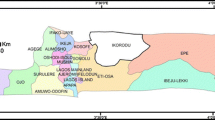Abstract
India has a long tradition of systematic collection of spatial data at national level by many national map** organizations (NMOs), which are quite old. Several line departments in state governments and their agencies acquire a lot of geospatial data to support their decision-making and conduct their businesses. However, these data sets seldom get integrated into the organizational work flow processes as in most cases, they are out of date, inaccessible; not of right resolution and required accuracy ; not searchable or discoverable; and not amenable to quick retrieval, analysis and integration. These deficiencies are stumbling blocks in improving the planning capabilities of local government departments (LGDs) who could be the major users of geoinformation in their work processes and provide a pull factor to the Indian National Spatial Data Infrastructure (NSDI ). Unless the local government departments have the technical, organizational and institutional capacities to build up Local Spatial Data Infrastructure (LSDI) for satisfying the local demand and to absorb federal supply, federal initiatives like the Natural Resources Data Management System (NRDMS), National Natural Resources Management System (NNRMS) and last but not least the NSDI will have few chances of success. With the above understanding, State Spatial Data Infrastructure (SSDI) initiative had been launched by the DST as a follow-up of the meeting of the Chief Secretaries in the Cabinet Secretariat on 4–5 February 2011. As a result, currently, SSDI activities have been initiated in the states of Kerala, Karnataka, Uttarakhand, Haryana, West Bengal, Odisha, J&K, Nagaland and Jharkhand. However, the status of SSDIs’ developments is at different stages due to varied levels of technical and organizational capacity, political support, consensus building, partnerships and leadership, institutional and policy framework, appropriate state-level funding support. The identified key components for successful operation of a SSDI are technology, data, institutional mechanism, people and policy . In this chapter, standard operating procedures (SOP) and best practices about different components of SSDIs out of the experiences in various operational states have been discussed. Attempts have also been made to project the long-term strategy for sustenance and evolution of SSDIs, where the role of future technologies has been discussed to address the sustainable developmental goals (SDGs).
Access this chapter
Tax calculation will be finalised at checkout
Purchases are for personal use only
Similar content being viewed by others
References
Sahay, S., Welsham, G.: The use of geographical information systems in develo** countries: social and management issues. In: Emerging technology Series. International Center for Science and High Technology and United Nations Industrial Development Organization, Vienna (1997)
McDougall, K.: A local-state government spatial data sharing partnership model to facilitate SDI development. Ph.D. Thesis: University of Melbourne (2006)
Hartmut Müller, H., Würriehausen, F.: A case study on local SDI implementation in Germany. In: Joint FIG Commission 3 and 7 Workshop and Commission 3 Annual Meeting Information and Land Management. A Decade after the Millennium, Sofia, Bulgaria (2010)
Rajabifard, A., Feeney, M., Williamson, I.P.: Future directions for the development of spatial data infrastructure. J. Int. Inst. Aerosp. Surv. Earth Sci. (ITC), The Netherlands (2001)
Author information
Authors and Affiliations
Corresponding author
Editor information
Editors and Affiliations
Rights and permissions
Copyright information
© 2018 Springer Nature Singapore Pte Ltd.
About this chapter
Cite this chapter
Dutta, D., Pandey, S. (2018). Development of State Spatial Data Infrastructure (SSDI): Indian Experience. In: Sarda, N., Acharya, P., Sen, S. (eds) Geospatial Infrastructure, Applications and Technologies: India Case Studies. Springer, Singapore. https://doi.org/10.1007/978-981-13-2330-0_4
Download citation
DOI: https://doi.org/10.1007/978-981-13-2330-0_4
Published:
Publisher Name: Springer, Singapore
Print ISBN: 978-981-13-2329-4
Online ISBN: 978-981-13-2330-0
eBook Packages: Computer ScienceComputer Science (R0)




